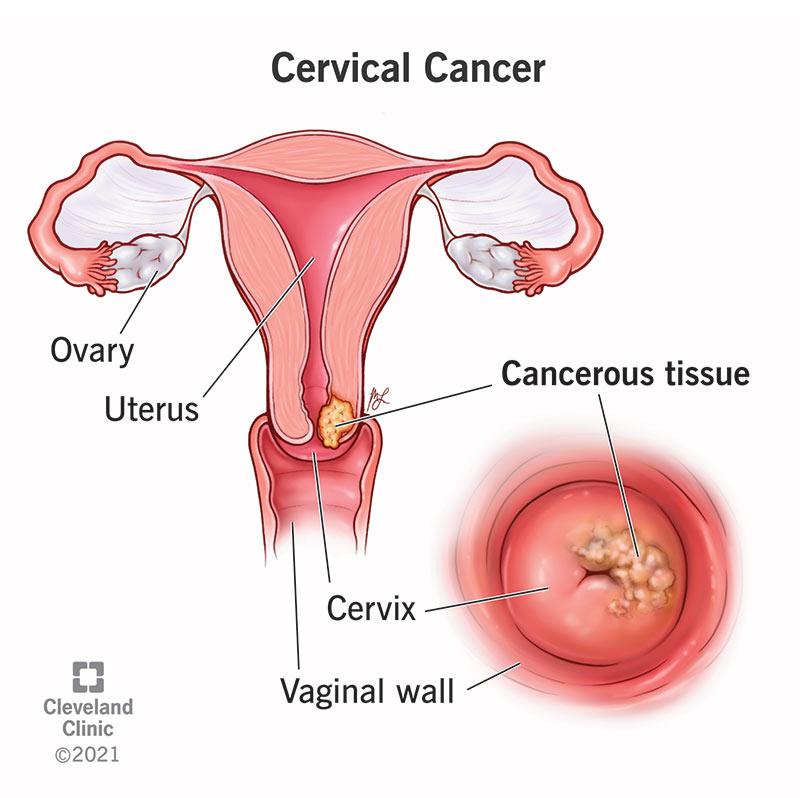Uncategorized
Cervical Cancer Awareness Month

According to WHO, cancer, a non-communicable disease, is a leading cause of death worldwide, accounting for over 10 million deaths in 2020. An abnormal condition in which cells of the body replicate uncontrollably due to genetic disruption, there are several kinds of this disease which are named according to the location of the malignancy in the body e.g. breast cancer, prostate cancer, colon cancer, etc.
In Nigeria, according to the National Cancer Control plan(2018- 2022), cancer is responsible for the death of about 72000 people yearly. In women, cervical cancer is the third most common cancer and the leading cause of cancer-related death in women, worldwide.
The disease begins in the cervix, the cylindrical inferior part of the uterus spanning about 3 to 5 cm and connecting it to the vagina. Different types of cervical cancer exist based on the type of cell it originates from. These types include squamous cell carcinoma, adenocarcinoma and mixed carcinoma.
Causes of Cervical Cancer
About 99% of cervical cancer is caused by infection with high-risk types of Human Papillomavirus ( HPV), a virus which can infect the anogenital and oral regions of the body. It is transmitted via sexual intercourse or direct contact.
Over 100 types of HPV exist with 12 of them affecting the anogenital region. These are referred to as oncogenic or high-risk, especially the HPV-16 and HPV-18 strains. They are the common cause of cervical cancer, and also genital warts.
It occurs largely among sexually active women.
Aside from HPV infection, other causative or risk factors of cervical cancer include:
- Weak immunity status of the individual ( Poor nutrition, HIV infection or other STDs). Cervical cancer is at least 5 times more common in HIV- infected women.
- Smoking cigarettes
- Early age at first intercourse.
- 3 or more past pregnancies.
- Obesity
- In utero exposure to diethylstilbestrol
- Genetic susceptibility by family history of cervical cancer
- Use of contraceptives for 5 years or more
- A higher number of sexual partners
- Failure to receive the HPV vaccine
The progress of the HPV infection depends on the persistence of the infection and the immunity of the woman.
Symptoms of Cervical Cancer
Cervical cancer is asymptomatic in the early stage. This is one of the factors that contribute to its lethality. However, the following symptoms can indicate the presence of cervical cancer:
- Unusual vaginal bleeding in between periods, after sex or after menopause.
- Abnormal and malodorous vaginal discharges
- Pain in the pelvic region
- Frequent urination
- Dysuria
- Abnormal menstrual cycles/periods (Oligomenorrhea, dysmenorrhea, amenorrhea, etc).
- Painful sexual intercourse etc.
Diagnosis of Cervical Cancer
Cervical Cancer can be diagnosed via the Papanicolaou ( PAP) smear or test, which was developed in the 1940s by Georgios Papanicolaou. The PAP test is a method of cervical screening used to detect precancerous and cancerous cells in the cervix.
A precancerous state of the cervix is diagnosed as cervical dysplasia or cervical intraepithelial neoplasia (CIN). This condition heralds the onset of cervical cancer as the cells are highly prone to becoming malignant.
Prevention of Cervical Cancer
An easy way to prevent cervical cancer is by getting screened with a pap smear test earlier. It is recommended for sexually mature women of about 21 years and above, with or without any sexual history to undergo the pap smear test for early detection ( if present) and management.
However, the most important key to preventing this cancer is by taking the HPV vaccine ( Gardasil or Cervarix). These vaccines protect against either two, four, or nine types of HPV, all inclusive of the 16th and 18th strains. Vaccination is most effective before a person becomes sexually active (before 25 latest). Vaccines can be obtained at standard immunisation centres or hospitals.
Treatment of Cervical Cancer
The treatment of Cervical Cancer depends on the stage of the disease i.e. localized (in the cervix), regional (in the pelvic region) or distant (metastasis to other parts of the body). For early stages, that is localized or regional, a combination of radiation therapy and low-dose weekly chemotherapy is often used. Sometimes, treatment might require any of these surgical procedures:
- Conization: the use of a conical instrument to remove the abnormal cells.
- Loop electrosurgical excision procedures (LEEP): the use of an electric loop to excise the malignant region.
- Hysterectomy: removal of the uterus and cervix. It can either be simple (removal of uterus and cervix) or radical (removal of uterus, cervix and upper part of the vagina)
- Radical trachelectomy: removal of only the cervix while the uterus is kept intact for conception purposes.
- Exenteration: it is the removal of all pelvic organs i.e. the uterus, urinary bladder, urethra, rectum and anus.
Other treatment forms include targeted therapy and immunotherapy.
In conclusion, as we round off the month of awareness, every woman must ensure she abides by the aforementioned measures to safeguard or reclaim her health from the grip of disease, even as she spreads the word to safeguard the next generation against the scourge.
Aladi Victoria


